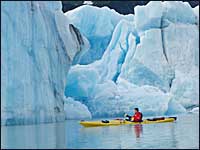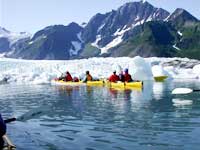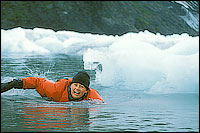



|
Hypothermia, Cold Water Immersion And Cold Water Shock
Our dry suits may be the favorite piece of padding gear you'll enjoy using on our trips. Backcountry Safaris Supplies Dry Suits  We supply dry suits for your comfort on all our rafting and kayaking adventures. Most outfitters will offer you rain gear to paddle in which may not help protect you from hypothermia in Alaska's cold water as well as a dry suit can. Your comfort is high on our list. Another advantage to dry suits is that in wet weather they add warmth and a comfort level you would not think possible in Alaska's environment. We supply dry suits for your comfort on all our rafting and kayaking adventures. Most outfitters will offer you rain gear to paddle in which may not help protect you from hypothermia in Alaska's cold water as well as a dry suit can. Your comfort is high on our list. Another advantage to dry suits is that in wet weather they add warmth and a comfort level you would not think possible in Alaska's environment.What is Hypothermia? Hypothermia is subnormal temperature within the central body. When a person is immersed in cold water, their skin and nearby tissues cool rapidly. However, it may take 10 to 15 minutes before the temperature of the heart and brain starts to drop. When the core temperature drops below 90° F serious complications begin to develop. Death may occur at about 80° F; however, a person may drown at a higher temperature due to loss of consciousness or inability to use the arms and legs. What is Cold Water Shock? Besides hypothermia, the initial shock of cold water can place severe strain on the body, producing instant cardiac arrest. In cold water immersion your breath can be driven from you and cause a phenomenon known as dry downing. Also called laryngospasm reflex, the cold shock can prevent you from breathing. Your larynx closes the airway and essentially causes asphyxiation; you suffocate since you are not able to breathe. Some people experience an involuntary reflexive gasp for breath and can inhale water rather than air if the face is in the water. Most of these immediate body responses are increasingly fatal as the water temperature decreases. What Happens In Cold Water?  Many of the fatal boating accidents accrue do to Cold Water Immersion and Hypothermia. What happens to the body when suddenly plunged into cold water? Many of the fatal boating accidents accrue do to Cold Water Immersion and Hypothermia. What happens to the body when suddenly plunged into cold water?The first hazards to contend with are panic and shock. The initial cold water shock can place severe strain on the body, producing instant cardiac arrest. Your breath will be driven from you on first impact with the water. Should your face be in the water during that first involuntary gasp for breath, it may well be water rather than air. Total disorientation may occur after cold water immersion. Persons have reported "thrashing helplessly in the water" for thirty seconds or more until they were able to get their bearings. Immersion in cold water can quickly numb the extremities to the point of uselessness. Cold hands cannot fasten the straps of a lifejacket, grasp a thrown rescue line, or hold onto an over-turned boat. Within minutes, severe pain clouds rational thought. And, finally, hypothermia (exposure) sets in, and without rescue and proper first aid treatment, unconsciousness and death.Normal body temperature of course, is 98.6° F. Shivering and the sensation of cold can begin when the body temperature lowers to approximately 96.5° F. Amnesia can begin to set in at approximately 94° F, unconsciousness at 86° F and death at approximately 79° F. We're Prepared  Preparation is the key to cold water paddling. You must dress appropriately for the water temperature regardless of the air temperature. A prepared paddler is always ready for an unexpected dunking. Any water colder than body temperature can start the effects of hypothermia and cold water shock. Water colder than body temperature is the norm even in southern rivers and lakes. In Alaska, water temperatures less than 40° F would not be that uncommon on many of our glacier rivers or when paddling around tidewater glaciers. Preparation is the key to cold water paddling. You must dress appropriately for the water temperature regardless of the air temperature. A prepared paddler is always ready for an unexpected dunking. Any water colder than body temperature can start the effects of hypothermia and cold water shock. Water colder than body temperature is the norm even in southern rivers and lakes. In Alaska, water temperatures less than 40° F would not be that uncommon on many of our glacier rivers or when paddling around tidewater glaciers.Every year we are amazed at how many of our fellow paddlers (including very experienced paddlers) that we encounter are not properly dressed for the environment they are in. Most Alaskan whitewater rafting companies have acknowledged that drysuits are essential gear needed for their guests. Sea kayaking companies have been slower to come around and even today very few sea kayaking outfitters furnish this essential piece of gear to their guests. Wearing a drysuit can increase your survival time and help protect you from cold water shock should you take an unexpected swim. Wearing a drysuites can increase these times greatly.
|
|
Alaska Sea Kayaking Trips Anchorage, Alaska |
Alaska Raft Trips Denali Park Nenana River Rafting 4 Day Chulitna River Rafting 7 Day Lake Creek Rafting Arctic Wildlife Refuge Rafting Trip Denali Natioanl Park Denali Park Tours and Activities Denali Park Bus Tours Denali Park Dog Mushing Tour Denali 4X4 ATV Trips 3- 5 Day Exclusive Denali Park Tour Denali Park Transportation Denali Hotels and Lodging Alaska Railroad Alaska Railroad Passenger Service Alaska Railroad, Train Day Tours Alaska Railroad, Multi-day Tour Packages Denali Train, Denali Star Train Seward Train, Coastal Classic Train Glacier Discovery Train Whittier Train, Portage Spencer Grandview Goldstar Train, Alaska Railroad Gold Star Dome Kenai Fjords Train Fairbanks Train Aurora Winter Train, Anchorage-Fairbanks Hurricane Turn Train, Talkeetna Flag Stop Train Alaska Railroad History Alaska Bus Passenger Service Denali - Anchorage Bus Denali - Seward Bus Denali - Talkeetna Bus Denali - Whittier Bus Seward - Anchorage Bus Homer - Anchorage Bus Talkeetna - Anchorage Bus Motor Coach Tours Escorted Motor Coach Tours Arctic National Wildlife Refuge Kongakut River 10 Day ANWR Rafting Trip Seward, Alaska Seward, Alaska Tours Seward Dog Sled Trips |
Seward Water Taxi Fairbanks, Alaska Tours |
Alaska Fishing Halibut Fishing Seward Salmon Fishing Seward Halibut fishing Homer Kenai River Fishing King Salmon Fishing Kenai River Float Fishing Trips Raft Fishing Trips Alaska Cruises Small Ship Alaska Cruise Holland America Alaska Cruises Princess Alaska Cruises Disney Alaska Cruises Alaska Cruise Specials Alaska Day Cruises Kenai Fjords Glacier Cruises Prince William Sound Glacier Cruises Pre-Cruise Vacations Packages Post-Cruise Vacation Packages Cruise Land Tours Cruise Lines Shore Excursion Alaska Winter Vacations Alaska Snow Machine Tours Anchorage Fur Rondy, Anchorage Winter Festival Iditarod Dog Mushing Race Chena Hot Springs Resort Northern Lights Tours Alaska Railroad Fairbanks tour Alaska Hotels and Lodging Anchorage, Alaska Hotels Seward, Alaska Hotels Seward B&B and cabins Fairbanks, Alaska Hotels Denali Park Hotels Denali Cabins Denali Backcountry Lodges Denali Lodges Homer, Alaska Hotels Princess Hotels & Resorts Princess Lodges Vancouver, Canada Hotels |



 Did You Know?
Did You Know?
 The ancient Aleut name for a sea kayak is Iqyak and sea kayaking history goes back thousands of years. Archaeologists have found evidence that the native people of Alaska, northern Canada, and Southwest Greenland developed this sea going craft to hunt seals and walrus back as far as 4000 years ago.
The ancient Aleut name for a sea kayak is Iqyak and sea kayaking history goes back thousands of years. Archaeologists have found evidence that the native people of Alaska, northern Canada, and Southwest Greenland developed this sea going craft to hunt seals and walrus back as far as 4000 years ago.